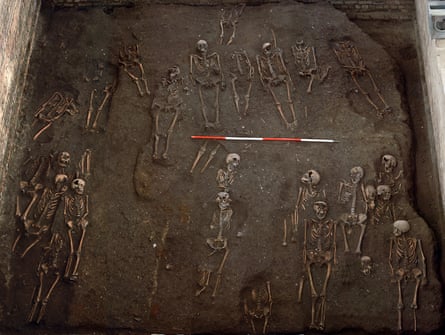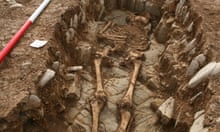Archaeologists at Cambridge University have reconstructed the “biographies” of hundreds of the city’s ordinary medieval residents by examining their skeletons in detail, using a wealth of scientific data to fill out the life stories of poor or disadvantaged people whose names were never recorded.
By examining the bones of more than 400 adults and children who were buried in the grounds of a medieval hospital between AD1200 and 1500, the researchers have built up a detailed picture of the lives, health and even appearance of those who lived and died in Cambridge in the period.
They also gained clues to how the charitable institution operated its medieval “benefits system” and decided who was worthy of help in what must have been an overwhelming “sea of need”.

The people buried in the hospital, they discovered, didn’t come from one social class but included orphan children, university scholars and a category of people they call the “shame-faced poor” – people who had previously lived in relative prosperity but had fallen on harder times, and who were deemed particularly worthy of charity.
The site of the hospital of St John the Evangelist was excavated in 2010, uncovering hundreds of unidentified graves. For the new study, experts in DNA and isotope analysis, human skeletal variation and a range of other disciplines examined up to 50 individual characteristics of each skeleton, to build what they believe is one of the richest such datasets ever compiled for medieval England.
A new website, launched on Friday to accompany a research paper published in Antiquity, tells the stories of some of the people they found there. They include a stocky, dark-haired man experts have speculatively named “Wat”, who grew up with a good diet and survived several waves of the Black Death, but seems to have fallen on hard times and died with cancer around the age of 60.
Another individual, “Maria”, was very short because of an impoverished childhood and did heavy manual work before contracting tuberculosis. She was probably admitted to the hospital where her diet improved, but died in her early 20s.
About 10 male skeletons were identified as probable university scholars thanks to the symmetry of their arm bones, which suggested, unlike most of the young male skeletons, that they didn’t perform heavy manual work.
“The people in the hospital weren’t purely an underclass, there were different ways people arrived there,” said John Robb, professor of archaeology at Cambridge University and the study’s lead researcher. “That gave us a peek behind the scenes. Only a limited number of people could go into the hospital and there must have been many more who might have deserved help. That poses the question of how decisions were actually made.”
The likely answer, the authors conclude in their paper, was that by caring for different types of people, they could appeal to a diverse range of donors and their emotions, helping to ensure the hospital’s survival for 300 years.









